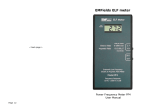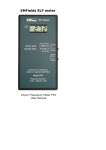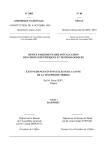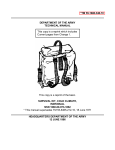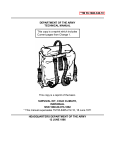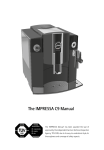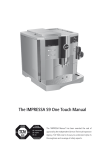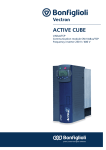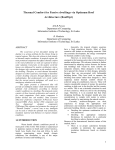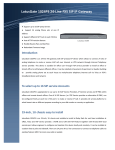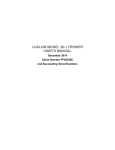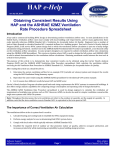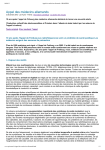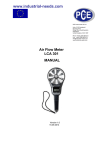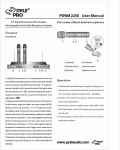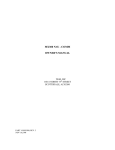Download Acoustimeter User Manual
Transcript
Acoustimeter User Manual Safety Instructions Please read through these instructions carefully before operating the instrument. This contains important information regarding usage, safety and maintenance. The instrument is not waterproof and should not come into direct contact with water, nor should it be used outdoors in the rain. If it is raining and you want to take measurements outside, please cover the instrument in a plastic bag that does not have holes in it. Clean the case using a damp cloth if necessary and do not use detergents. This instrument is not intended to be serviced by the user neither does it need any special maintenance. Unscrewing the case will void the guarantee. This instrument is sensitive to heat and impact. Exposing the instrument to high temperatures or dropping the meter on to a hard surface may cause it to stop functioning properly. It may not display properly while it is in temperatures below freezing (0°C). 2 Contents Safety Instructions .......... 2 Technical Specifications .. 4 Introduction .................... 5 Layout of the meter ........ 6 Operation and use .......... 7 LED displays ..................... 13 Troubleshooting .............. 14 Exposure Guidance ......... 16 Guarantee ...................... 18 Approvals and Contact ... 19 3 Technical Specifications Typical overall frequency response using the internal antenna: 200 MHz – 8000 MHz ± 3dB ± 0.01 V/m 150-200 MHz and 8-10 GHz ± 6dB Measurement Range: Peak: 0.02 - 6.00 volts per metre, V/m Average 1-100 000 microwatts/sq.metre µW/m2 The detector can respond to levels below 0.02 V/m - audio from demodulation may be heard at levels below 0.02 V/m. The LCD displays peak-hold (since turned on), peak and average values. Peak LED Scale Points updated c. 100 ms: 0.02, 0.03, 0.05, 0.07, 0.1, 0.2, 0.3, 0.5, 0.7, 1, 1.5, 2, 3, 4.5, 6 V/m Average 6400 samples updated c. 250 ms: 1, 5, 10, 25, 50, 100, 250, 500, 1 000, 2 500, 5 000, 10 000, 25 000, 50 000, 100 000 µW/m2 Power: c.90-125 mA at 3 volts (2xAA Alkaline or NIMH rechargeable cells @ 1.2 - 1.5V) Battery Life: typically 15 to 20 hours. ‘Low battery’ detection is indicated. Size: 190mm x 102mm x 33mm (LxWxD) Weight: 275g, excl. batteries, 320g with. 4 Introduction The Acoustimeter has been designed to enable you to make a quick and informed judgement regarding the level and nature of microwave signals in your environment. The Acoustimeter is a broadband meter that measures the totality of the radiation in the range 200 MHz to over 8000 MHz (8 GHz), which covers the frequencies used by most modern communication systems in our everyday environment. It was designed using the experience gained from many years of practical RF and microwave measurements using a wide variety of professional instruments. Readings are shown on both an LCD display and two series of graduated LED lights. The LEDs update rapidly, and allow you to quickly gauge the levels in an area and find any hot-spots. The Acoustimeter also has a loudspeaker (and audio output socket for headphones or an audio recorder), allowing you to determine, with a small amount of practice, what type of device is creating the signals. Sound samples and a RF unit converter to help you identify different signals are available on: http://www.emfields-solutions.com/rf 5 Layout of the meter Key: 1. Display 2. Peak signal LEDs 3. Average power LEDs 4. Audio jack, mono, 3.5mm 5. Volume control 6. On - Off switch 7. Internal Antenna 8. Loudspeaker 9. Battery compartment 6 Operation and use Ensure that you have correctly inserted correct batteries (2 x AA cells). Move the power switch into the “On” position. The LEDs should at once display a moving pattern across all LEDs and the LCD should briefly display “Acoustimeter v04 © EMFields 2015” changing to readings after a short time. Hold the bottom of the instrument in one hand at least 30cm from your body as close proximity to your body will affect the readings. Keep your hands away from the top of the instrument as the antenna is located inside the case at the rear towards the top. The Acoustimeter can be located upright on a surface, but people nearby can still affect the RF/microwave levels. Adjust the volume to suit level (usually somewhere about mid-volume is best; only use maximum with weak signals). The instrument will display the peak signal strength and the average power on both the LEDs and the LCD. Slowly turn the instrument around in all directions for the best reading. Hold it still to take a reading. Bear in mind that even moving the meter small distances can result in detecting very different levels of microwave energy. 7 Microwaves are reflected off the ground and other surfaces so it is important to check all angles. The highest readings will often be found when holding the instrument facing you at an angle between horizontal and vertical. We recommend taking the highest reading found in any one spot, as this is when the antenna is most closely aligned with the directionality of the signal. The “Peak-hold” function will display the highest peak reading measured until the instrument is turned off and on again. If there is hardly any noise with the volume turned up then the instrument is not detecting any amplitude modulated (i.e. “pulsing”) signals. Various sounds represent the amplitude modulation and digital pulsing of RF signals detected by the instrument. It is sometimes possible to hear voices and music when very close to powerful medium and short-wave AM transmitters, which are outside of the normal RF frequency detection range of the meter. When no LEDs are illuminated any regular very quiet ticking sounds should be ignored - they are due to the internal functioning of the meter. 8 Why are there two different readings? The Acoustimeter is unique in the way it displays information about its readings. There are two different displayed results, showing values for Peak and Average measurements. At first, this may seem confusing. We believe that it is important to know both when assessing your exposure to modern telecommunication signals. We believe that it is the peaks in pulsing signals that are the most bio-active at typical modern relatively low exposure levels. Digital and Analogue? Most modern wireless devices use a digital system of communicating. These include mobile phones, WiFi, Cordless phones (DECT), Digital TV & DAB Radio. Many modern digital systems turn the signal on and off at high speeds to represent data, often with extra gaps between data bursts. This produces a non-continuous signal, which we describe as “pulsing”. The Acoustimeter allows you to hear this as one way of identifying the signals. An analogue signal is a system of communication that is not digital. They use a continuous carrier, and instead of turning “on and off” to represent data, will vary the frequency (FM) or strength (AM). 9 Differences between peak & average With an analogue system, the peak and average levels should be similar, as the signal is continuously on while it is being used. However, because most digital systems spend a large proportion of their time not transmitting, the average level does not represent the actual waveform even though it is technically accurate as shown in the diagrams below. 10 Why does this matter? Since wireless communications were first developed on a large scale, the scientific community held the opinion that “if it does not heat you it will not hurt you”, as 50 years ago, these were the only effects that were acknowledged. The average heating effect was what mattered. The units typically used now for measuring the timeaveraged power of microwave frequency EMFs is microwatts of power arriving per square metre (µW/m2), and we have used this for the “average power”. There have now been hundreds of studies finding non-thermal effects from modern wireless communication signals. This requires a change in what is measured to suit much lower signal levels with different characteristics. We believe that peak signal strength is the most appropriate way to measure complex digitally modulated, often non-continuous, signals in a meaningful manner. Signal strength is measured in volts per metre (V/m). Many electrosensitive individuals report most adverse health effects in areas that have quite high peak levels but have average field strengths below even precautionary guidelines regarding average power levels. 11 The Acoustimeter calculates the average power in the measured RF by an analysis of the waveform. The average power is shown on the LEDs and on the LCD display. The LED points on each of the scales are approximately equivalent across the two columns of LEDs for continuous wave (CW) signals. The more pulsatile the signal is, the higher the peak scale will read in comparison to the average power scale. The EMFields website has an RF unit converter for CW signals on this page: http://www.emfields-solutions.com/rf What do the LED colours mean? Our peak signal strength scale is coloured based on the levels that electrosensitive people report as adversely affecting their health. Below 0.05 volts per metre (V/m), few people report ill-effects, so these are green. Between 0.05 and 0.5 V/m, some individuals report ill-effects, so these are yellow. Above 0.5 V/m, nearly all sensitive individuals report experiencing adverse health effects, so these are red. The average power density scale LEDs are all orange in colour. 12 1 W/m2 = 1,000,000 µW/m2 = = 100 µW/cm2 = 0.1 mW/cm2 13 Troubleshooting The meter is not working. Check switch is in the “on” position. Check that the batteries are correctly fitted. The batteries may be flat. Try changing them. Note: If the LCD is displaying a reading, then the meter is turned on and working. LCD is blank or shows black squares. Make sure that you leave 1 second between turning it off and turning it on again. The meter makes three loud beeps. Check for a “Low battery” screen message next time it beeps. Replace the batteries. The instrument readings are varying. Make sure your fingers are clear of the antenna. Modern signals pulse and peak signals are not consistent. The instrument is sensitive and picks up these variations. Regular high “blips” every few seconds may be due to a rotating radar transmitter or a WiFi signal. The peak signal is high, but the average signal is low. This is to be expected from many modern pulsing digital microwave signals. The levels are very low (no LEDs lit), but I can just hear a slow, regular, ticking (a bit like a very faint heartbeat) This is the instrument picking up its own internal meter circuitry and not external signals. This only happens if the field levels are below 0.02 V/m and no LEDs are lit. 14 The instrument is giving readings that surprise me. Are they correct? Our extensive tests have shown that the Acoustimeter readings usually give a good indication of the microwave levels present. Measuring pulsing RF signals over a wide frequency range is extremely difficult to do. Even professional instruments costing many thousands of pounds have quite large error margins. How you should add all the various frequencies and waveforms is a large debate on its own. Different meters may well give different readings depending on what is being measured. Many budget meters incorrectly display a high peak power derived from peak signal strength as if it were a CW signal. It still makes a noise when inside a headnet or behind my screening The audio section of the Acoustimeter is sensitive so even low signals can seem quite loud. Check the figures that the Acoustimeter is displaying. A 99.9% reduction of 100000 µW/m2 to 10 µW/m2 (a 2 V/m signal reduced to 0.05 V/m) will still be showing and sounding on the meter. Close to transmitting sources it is likely that you will still hear something. The screening material may have degraded over time, or you may have a gap in your screening. Even small gaps (including above and below you) will let in microwave signals. 15 General Public Levels ICNIRP, 1998 (recognised by WHO, EU & UK ) Russia 2003 (general public), PRChina Italy, Decree 381 (1999) Frequency MHz 400 900 1800 2100 300 - 300000 30 - 30000 Swiss Ordinance ORNI, rms values , (for base stations) 1st. Feb. 2000 EU & UK EMC suscept. regulations 900 1800 30 - 2000 Belgium - Wallonia 900, 1800, 2100 Typical max in public areas near base station masts (can be higher) 900, 1800, 2100 USA City Dweller max (FCC 1999) 30 - 300000 Wien (Vienna) Sum of GSM Italy (2003) each base station (aim); Lichtenstein law from 2013 Salzburg - 1998 & 2000 900, 1800, 2100 Sum of GSM BioInitiative, 2007 30 - 300000 EU-Parliament bill, GD Wissenschaft, STOA GSM (2001) 900, 1800, 2100 Typical US (EPA 1980, mainly FM & TV) 30 - 300000 Salzburg - 2002, outside houses aim 900, 1800, 2100 BioInitiative, 2012 (guidance) 30 - 300000 Salzburg - 2002, inside houses 900, 1800, 2100 Mobile phones will work at levels 900 - 2100 Broadband ‘natural’ background 300 - 3000 16 Frequency MHz E field V/m Power W/m2 Power µW/m2 400 900 1800 2100 28 41 58 61 2 4.5 9 10 2 000 000 4 500 000 9 000 000 10 000 000 300 - 300000 6 0.1 100 000 30 - 30000 6 0.1 100 000 900 1800 4 6 not spec not specified 30 - 2000 3 not spec not spec 900, 1800, 2100 3 0.024 24 000 900, 1800, 2100 2 0.01 10 000 30 - 300000 <2 < 0.01 < 10 000 Sum of GSM 1.9 0.01 10 000 900, 1800, 2100 0.6 0.001 1000 Sum of GSM 0.6 0.001 1000 30 - 300000 0.6 0.001 1000 900, 1800, 2100 0.2 0.0001 100 30 - 300000 < 0.13 <0.00005 < 50 900, 1800, 2100 0.06 0.000 01 10 30 - 300000 0.03 0.000 005 5 900, 1800, 2100 0.02 0.000 001 1 900 - 2100 0.00001 < 3 e-11 < 0.000 03 300 - 3000 <0.00003 < 1 e-13 <0.0000001 17 Disclaimer While EMFields considers that the information and opinions given here are sound, you must rely upon your own skill and judgement when interpreting or making use of the information contained in this manual. Guarantee The Acoustimeter comes with a 2 year return-to-base Guarantee. Please contact us (see page 19) for details and to arrange a return if required. The meter is guaranteed to be free of manufacturing defects, but not against wear from normal use, nor damage caused by water or by physical impacts such as from dropping it. Please note: The Acoustimeter is a very sensitive meter. It has a degree of overload protection built-in, but it should not be used next to high-powered RF transmitters that are likely to grossly overload it. Approach these with caution and watch the displays to avoid gross overload. 18 EMFields Solutions Ltd 12 Mepal Road Sutton, Ely Cambridgeshire CB6 2PZ, UK Tel: (+44) (0)1353 778814 Email: [email protected] www.emfields-solutions.com European Approvals CE, ROHS and WEEE The Acoustimeter meets EN61000-6-3:2001+A11:2004 EN61000-6-1:2001 EMC standards and also meets ROHS 2 2011 (2002/95/EC) and WEEE (2012/19/EU) (2002/96/EC) The Waste Electrical & Electronic Equipment (WEEE) Directive requires that unwanted electronic equipment must be disposed of using specialist recycling. Your Acoustimeter can be returned to us for recycling. UK local waste recycling centres also provide free collection points for WEEE. v5.2 2015-03-11 19




















